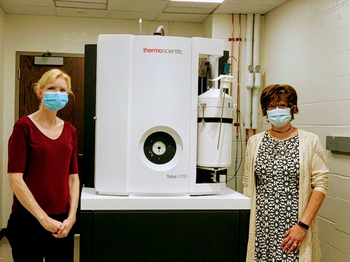News
Grant Will Fund M. Kerry O'Banion's Work on Space Travel & the Immune System
Tuesday, December 1, 2020
M. Kerry O'Banion, M.D., Ph.D. has been awarded $1.8 million from NASA to explore the effect space travel has on the immune system and bone marrow, and how that impacts brain function.
The grant is one of 21 research proposals recently awarded by NASA to help answer questions about astronaut health and performance during future long-duration missions, including crewed missions to the Moon and Mars.
Using simulated space radiation produced by particle accelerators at the NASA Space Radiation Laboratory at Brookhaven National Laboratory on Long Island, O'Banion and his team will examine tissue and cellular changes in genes, blood flow, and immune cell function in mice. Behavioral tests and computer-assisted imaging will also be used to quantify damage and inflammation in the brain.
O'Banion -- Professor of Neuroscience and Neurology in the Del Monte Institute for Neuroscience -- and colleagues previously worked with NASA on a study that showed exposure to a particular form of space radiation called high-mass, high-charged particles caused biological and cognitive changes in mice suggesting an accelerated risk for the development of Alzheimer's disease.
This time around, O'Banion will be working with Laura Calvi, M.D., an endocrinologist and co-director of the UR Multidisciplinary Neuroendocrinology Clinic. Her preliminary data found space radiation changes in bone marrow suggestive of a skewed phenotype, in which white blood cells are changed into a more inflammatory phenotype. Similar changes are found with aging. "This helps to bind a common hypothesis about dysfunction and degeneration in multiple systems, with the bone marrow communicating to the brain through the vasculature," O'Banion said.
Cool Technology Allows for Better Views of Cancerous Blood Cells in Quest for New Treatment
Tuesday, September 15, 2020

Clara Kielkopf, Ph.D., left, and Laura Calvi, M.D., stand by the University's new cryo-microscope
With the recent acquisition of Nobel Prize-winning technology and two new grants, Wilmot Cancer Institute researchers are streamlining their investigations into a malignant blood disease known as MDS, working toward discovering targeted therapies.
Laura Calvi, M.D., and Clara Kielkopf, Ph.D., are leading collaborative teams that will be using a device at the University of Rochester Medical Center — a cryo-electron microscope — that has ushered in a new era in biochemistry. The microscope allows scientists to see 3D snapshots and more details of living molecules than ever before, down to near-atomic resolution, to understand disease and uncover new ways to design drugs. The developers of the technology were awarded the Nobel Prize in Chemistry 2017.
Calvi and Kielkopf each received Edward P. Evans Foundation awards totaling $1.2 million for this project. Evans grants go to scientists seeking a cure for myelodysplastic syndromes (MDS), which originates in the bone marrow and disrupts healthy blood cell formation. MDS often leads to leukemia.
The Kielkopf lab will use the cryo-electron microscope to obtain 3D views of recurrent MDS mutations as guides for targeting molecular therapies. The modern microscope is the first of its kind in the Rochester region, Kielkopf said, and will be accessible to all UR researchers through the Electron Microscopy Shared Resource Laboratory. She is a professor of Biochemistry and Biophysics in the Center for RNA Biology.